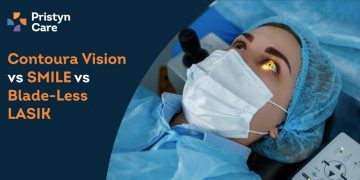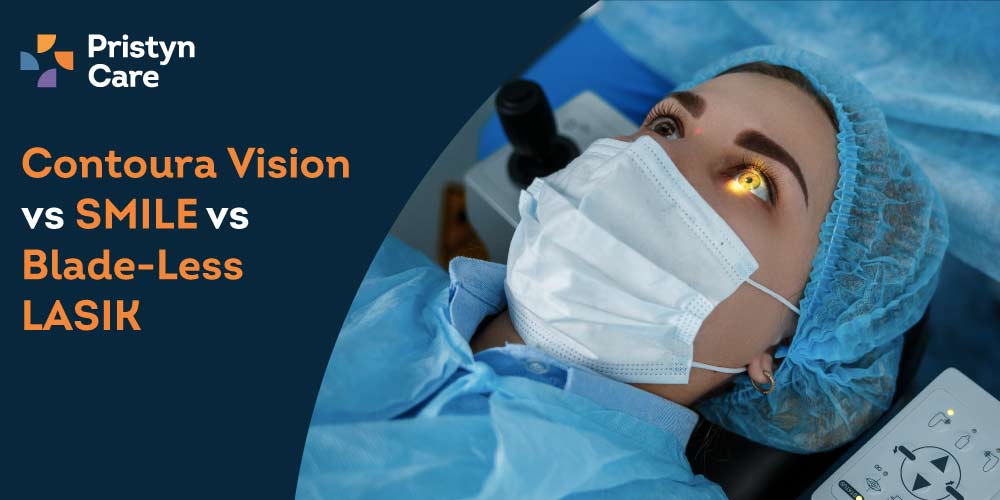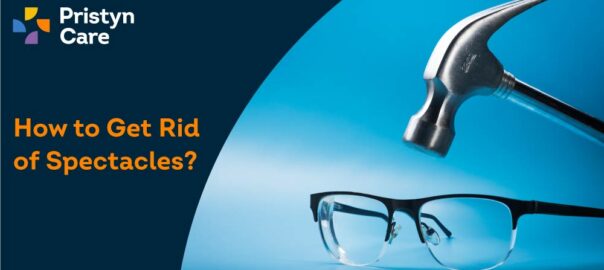![]() Views: 341
Views: 341
Contoura Vision vs SMILE vs Blade-less LASIK
Contoura Vision is a progressive vision correction procedure that employs cutting-edge, topography-guided LASIK technology. The aim is to precisely sculpt the cornea using a computer-driven excimer laser, thereby correcting vision issues like nearsightedness, farsightedness, and astigmatism.
Dedicated Support at Every Step!
Our Doctors are available 24 hours a day, 7 days a week to help you!
Call Us0806-541-7961Table of Contents
What Happens During Contoura Vision Surgery?
Here's a simplified rundown of what happens during Contoura vision surgery:
- Pre-operative assessment: A comprehensive eye examination, including corneal topography mapping, is carried out. This facilitates the creation of a 3D model of your cornea's surface providing an accurate map of its unique contours and irregularities.
- Anaesthetic eye drops: To ensure you are comfortable during the procedure, numbing eye drops are administered.
- Corneal flap creation: A femtosecond laser produces a thin, hinged flap on the corneal surface. This flap is temporarily folded back to reveal the underlying corneal tissue.
- Corneal reshaping: With the detailed data from the corneal topography mapping, the excimer laser is programmed to minutely remove corneal tissue. The objective is to flatten or steepen specific areas of the cornea as required to rectify refractive errors.
- Flap replacement: Once your cornea has been reshaped, the thin flap is restored to its initial position where it naturally adheres without stitches.
- Post-operative care: After surgery, antibiotics and anti-inflammatory eye drops are prescribed to prevent infection and encourage healing. You might experience minor discomfort and fluctuations in vision initially but can usually resume your day-to-day activities within a week.
Contoura Vision is a minimal pain procedure that does not need injections or hospitalization. Compared to traditional LASIK, it offers a more personalized approach by addressing individual corneal irregularities, often leading to sharper vision and fewer visual disturbances.
No Cost EMI, Hassle-free Insurance Approval
What Happens During SMILE Eye Surgery?
SMILE, or Small Incision Lenticule Extraction, is a minimally invasive procedure that uses a laser to correct vision problems like nearsightedness and astigmatism. Here's an easy-to-understand guide on what happens during a SMILE surgery:
- To start, anaesthetic eye drops are put into your eyes to numb them. This ensures you won't feel any discomfort during the operation.
- The doctor then utilises a femtosecond laser to form a thin, disc-like piece of corneal tissue called a "lenticule" within the layers of the cornea. This step is quick, taking less than half a minute.
- Subsequently, the same laser also makes a small incision, about 2-4 mm in size, on the side of the cornea.
- Using a specific tool, the surgeon delicately separates and extracts the lenticule through this small slit. This alters the shape of your cornea to correct your vision.
- You'll be pleased to learn that no stitches are necessary as this tiny cut heals naturally.
- The entire process is swift too, taking roughly 10 minutes per eye.
Following surgery, patients usually notice an improvement in their vision within just 24 hours. And it only continues to get better over the next week as your cornea recovers. Comparatively, to other laser vision correction procedures like LASIK, SMILE has several advantages such as smaller incision size, quicker recovery of corneal sensation and dry eye symptoms, and potentially enhanced biomechanical stability of the cornea.
What Happens During Bladeless LASIK Surgery?
Bladeless LASIK, known too as all-laser LASIK, is an innovative vision correction procedure. Instead of using a surgical blade (microkeratome) like in traditional LASIK, it employs a femtosecond laser to create the corneal flap. Here's what happens during this procedure:
- The process starts with your doctor administering anaesthetic eye drops. This makes your eyes numb and ensures you don’t feel discomfort during the procedure.
- The surgeon then uses a femtosecond laser to create a thin flap in your cornea. This procedure is quick and takes less than 30 seconds.
- The laser makes a precise cut on the flap with a predetermined thickness and diameter, ensuring an even flap.
- After this, the corneal flap is delicately folded back, revealing the underlying corneal tissue.
- An excimer laser is then utilised to eliminate tiny amounts of corneal tissue. This reshapes your cornea and rectifies vision issues like astigmatism, nearsightedness, or farsightedness.
- The corneal flap is then returned to its original position where it naturally sticks without stitches.
- Finally, antibiotic and anti-inflammatory eye drops are prescribed to ward off infection and encourage healing.
With bladeless LASIK eliminating risks associated with using a surgical blade, it's deemed safer than traditional LASIK. It also promises faster visual recovery and fewer dry eye symptoms for many patients. Notably, the entire procedure takes around just 10 minutes per eye as an outpatient surgery, which means you can head home the same day.
Who is the Right Candidate for Contoura Vision Eye Surgery, SMILE Surgery and Blade-less LASIK Surgery?
Deciding if one is an ideal candidate for eye surgery can seem a bit daunting. Let's break it down into three different procedures:
Contoura Vision Eye Surgery:
- You must be at least 18 years old with stable vision for the past year or two.
- Your eyes should have up to -9.00 D of myopia (short-sightedness) and up to 3.00 D of astigmatism (blurred vision).
- Ideal if you have mild to moderate refractive errors and your corneas are healthy and regular.
- Contoura Vision takes advantage of advanced topography mapping to correct even slight corneal irregularities.
SMILE Surgery:
- Again, you need to be a minimum of 18 years old with consistent vision for about a year or two.
- Your eyes should have up to -10.00 D of myopia and up to 5.00 D of astigmatism.
- Your corneas must be in good health, with a regular shape.
- A unique aspect of SMILE is its minimally invasive nature, creating a tiny lenticule within the cornea which is subsequently removed.
Blade-less LASIK Surgery:
- You must be at least 18 years old with stable vision for the previous one to two years.
- Your eyes can have up to -12.00 D of myopia and up to 6.00 D of astigmatism.
- Just like the other two surgeries, your corneas need to be healthy and regular.
- Blade-less LASIK employs a femtosecond laser instead of a surgical blade for creating the corneal flap, offering more precision and safety.
The important point to remember is that all three surgeries necessitate healthy, stable eyes, and no significant corneal irregularities. Consult with an experienced ophthalmologist to determine the best surgery type for your specific eye health and needs.
Risks and Complications of Laser Vision Correction Procedures
While laser vision correction procedures like Contoura Vision, SMILE, and Bladeless LASIK are usually safe and beneficial, we should also consider potential risks and complications. It's important to note these risks are significantly low if the procedure is conducted by an experienced and qualified eye surgeon.
Contoura Vision Risks and Complications:
- Dry Eyes: After the Contoura Vision procedure, patients may experience temporary dry eye symptoms. However, these usually improve as the cornea heals over a few weeks or months.
- Visual Disturbances: In the initial months post-surgery, some patients may face glare or halos, or have difficulty with night vision. These issues gradually improve over time.
- Infection: There's a minor risk of eye infection which can usually be addressed with antibiotic eye drops.
- Flap Complications: Issues related to the corneal flap such as improper healing are rare but possible.
- Undercorrection or Overcorrection: The laser, in some instances, may not fully correct the refractive error necessitating an enhancement procedure.
SMILE Surgery Risks and Complications:
- Dry Eyes: Dry eye symptoms common after SMILE are often less severe and shorter-lasting compared to LASIK.
- Visual Disturbances: Glare, halos, and trouble with night vision can occur but at a lower incidence than LASIK.
- Infection: The small incision in SMILE carries a minimal risk of eye infection.
- Incomplete Lenticule Removal: Rarely, the surgeon might not be able to fully remove the lenticule requiring additional treatment.
- Corneal Ectasia: This infrequent complication involves weakening and bulging of the cornea leading to vision problems.
Bladeless LASIK Risks and Complications:
- Dry Eyes: Like traditional LASIK, dry eye symptoms are common after Bladeless LASIK.
- Visual Disturbances: Glare, halos, and problems with night vision can occur but usually at a lower incidence than traditional LASIK.
- Infection: The risk of eye infection is relatively low as the corneal flap is created using a laser rather than a blade.
- Flap Complications: Similar to Contoura Vision, issues with the corneal flap are rare.
- Undercorrection or Overcorrection: In certain cases, the laser may not fully correct the refractive error.
Patients must discuss the specific risks and benefits of each procedure with their ophthalmologist to choose the best option according to their individual requirements and eye health.
Key Differences Between Contoura Vision, SMILE, and Bladeless LASIK
Here is a concise comparison of the key differences between Contoura Vision, SMILE, and Bladeless LASIK:
| Feature | Contoura Vision LASIK | SMILE | Bladeless LASIK |
| Corneal Mapping | Uses advanced computer algorithm to analyze over 22,000 points on the cornea | Uses a femtosecond laser to create a small lenticule (lens-shaped tissue) | Uses a femtosecond laser to create a corneal flap |
| Laser Used | Excimer laser only | Femtosecond laser only | Femtosecond laser for flap, excimer laser for reshaping |
| Accuracy | Highly accurate, 98% achieve 20/20 vision or better | Less accurate than Contoura, 60-85% achieve 20/20 vision | Highly accurate, similar to Contoura |
| Astigmatism Correction | Can correct up to 6 diopters of astigmatism | Can only correct up to 5 diopters of astigmatism | Can correct up to 6 diopters of astigmatism |
| Hyperopia Correction | Can correct hyperopia (farsightedness) | Cannot correct hyperopia | Can correct hyperopia |
| Recovery Time | Next-day recovery with minimal discomfort | Typically takes 3 weeks to recover | Next-day recovery with minimal discomfort |
| Side Effects | Fewer side effects like dry eye, halos, and glare compared to LASIK | Similar side effect profile to LASIK | Fewer side effects like dry eye, halos, and glare compared to LASIK |
Contoura Vision LASIK is the most advanced and accurate laser vision correction procedure, providing excellent visual outcomes with fewer side effects. Bladeless LASIK is also highly accurate but not as sophisticated as Contoura. SMILE is a less invasive procedure but is less accurate and has a more limited treatment range compared to the LASIK variants.









